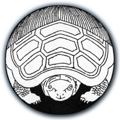Halving the Bones
“Her mother could not go to the grandmother’s funeral. It was bad timing. So Ruth went instead. The Japanese relatives thought that having some bones would be a nice consolation for the mother. So they had performed ‘hone wake,’ the ‘dividing of the bones.’”
Halving The Bones: the fractured history of a skeleton in the closet.
Written, produced and directed by Ruth Ozeki.
Color / black & white, 70 minutes, 1995.
Skeletons in the closet? Halving the Bones delivers a surprising twist to this tale. The film tells the story of the half-Japanese filmmaker, Ruth, who has inherited a can of bones that she keeps on a shelf in her closet. The bones are half of the remains of her dead Japanese grandmother — the rest are buried in a cemetery in Tokyo. In a narrative and visual web of family lies and stories, home movies and documentary footage, Halving the Bones traces one hundred years of Ruth’s maternal family history, from Japan, to Hawaii, to a suburb in Connecticut.
On one hand, Ruth’s quest is a simple one, to bring the bones of her grandmother home to her mother, who has become alienated from her family and her past. The film is the vehicle for the reuniting the three generations in (more or less) corporeal form. But Ruth, who is “halved,” has a problem with integrity, and nothing is quite as simple as it seems. As the film unfolds, she leads us in an equivocal inquiry into the shifty nature of memory and the documentary genre itself.
The story is told in three parts. The first part is Ruth’s “fantastic” trip through her family archives to tell the turn-of-the-century story of her grandmother’s journey to Hawaii as a picture bride to marry an eccentric photographer and poet. In a humorous turn-around, Ruth introduces Part Two by debunking these fantastic stories as a product of her own cultural confusion. As she drives home to her mother’s house with the bones, she constructs a wry yet compelling depiction of her alienation from her Japanese ancestry as a child growing up in Connecticut. The third section of the film is “pure” documentary. Ruth and her mother unpack a box of the grandmother’s possessions and in so doing, reopen a channel of communication that had been lost to them. Ruth’s mother accepts the bones and, in a strangely moving climax, makes a decision about how best to set them to rest.
Like Ruth, her film is “half.” Neither documentary nor fiction, it rides the edge between the two, searching for a more integrated way of imagining the world.
Awards, Festivals, & Screenings
- Sundance Film Festival
- International Documentary Association Distinguished Achievement Award
- Kodak Award for Creative Cinematography
- Margaret Mead Film Festival
- Montreal World Film Festival
- San Francisco Asian American Film Festival
- San Francisco International Film Festival Certificate of Merit
- Sydney & Melbourne Film Festivals
“Combining imagined home movies, true stories, tall tales and her own playful nature, Ozeki breaks the rules of documentary filmmaking and is all the better for it.”
“**** Editor’s Choice. One of my top one or two faves. Ozeki is both a terrific storyteller and a sly visual trickster; she seems to delight in keeping us off-guard, awake and thinking. Highly recommended for public and academic library collections.”
“A lyrical and sharply-observed film .”

